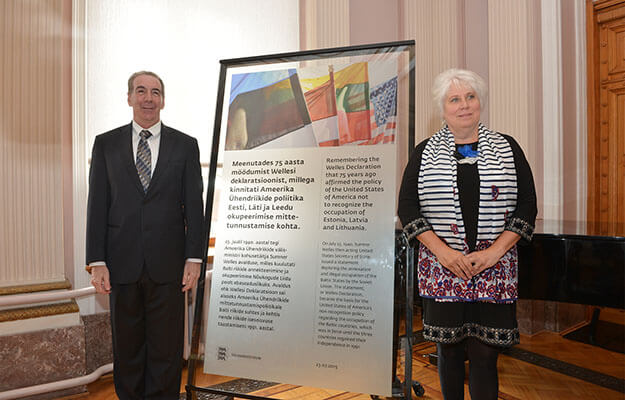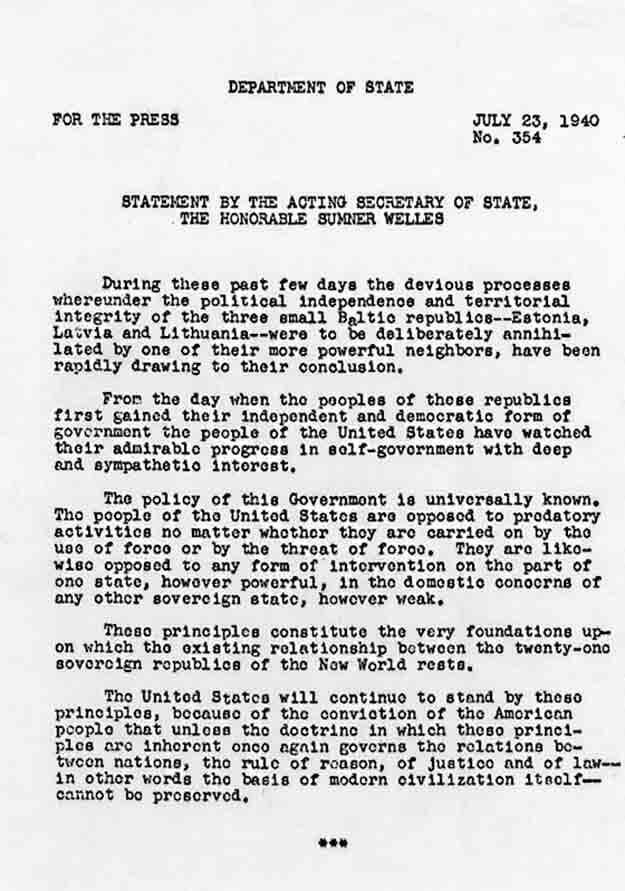
Foreign Minister Marina Kaljurand and the US Ambassador to Estonia, Jeffrey D. Levine, commemorated the Welles Declaration on July 23, in Tallinn. Photo by FM
On July 23, 1940, the acting US Secretary of State, Sumner Welles, issued a declaration that condemned the Soviet Union’s aggression against Estonia, Latvia and Lithuania.
On Thursday, July 23, 2015, Foreign Minister Marina Kaljurand and the US Ambassador to Estonia, Jeffrey D. Levine, commemorated the event at the special symposium, while the US Secretary of State John Kerry also issued a statement.
The Welles Declaration clearly stated that the invasion by the Soviet Union, which soon led to the annexation of the Baltic states was unacceptable and initiated refusal by the United States to recognize the legitimacy of Soviet control over these three states for the next 51 years.
“On behalf of President Obama and the people of the United States, I join Estonia, Latvia, and Lithuania in commemorating the 75th anniversary of the Welles Declaration, which condemned the forced annexation of these brave nations by the Soviet Union in 1940. We remember this declaration, issued by acting Secretary of State Sumner Welles on July 23, 1940, as an indelible sign of our shared commitment to freedom, sovereignty, and territorial integrity,” Kerry said in the statement.
“The Welles Declaration was more than a temporary symbolic gesture. From 1940 until the full restoration of Baltic independence half a century later, the flags of Estonia, Latvia, and Lithuania continued to fly in Washington, just as their peoples continued to believe that the day would come when liberty returned. Throughout the long years of Soviet occupation, the commitment of the United States to Baltic freedom never wavered,” Kerry added.
On July 23, while speaking at the symposium dedicated to the 75th anniversary of the Sumner Welles declaration and unveiling of the memorial plaque at the hall of the Estonian Academy of Sciences, Marina Kaljurand acknowledged the role of the US non-recognition policy in the restoration of Estonian independence. Kaljurand said that non-recognition continues to be topical today in connection with the illegal annexation of Crimea by Russian Federation and the situation in eastern Ukraine.
“Together we must pursue the vocal condemnation of the illegal annexation of Crimea and strongly carry out non-recognition,” Kaljurand said. “Ukraine must be able to regain control over its internationally recognized borders,” she added.
The US Ambassador Levine also spoke at the symposium, saying “America has watched with admiration at how the Baltic nations have built up strong democratic institutions and have taken their rightful place in the European and transatlantic community,” the ambassador paraphrased John Kerry.

THE WELLES DECLARATION clearly stated that the invasion by the Soviet Union, which soon led to the annexation of Estonia, was unacceptable and initiated its refusal to recognise the legitimacy of Soviet control over these three states.The US president at the time, Franklin D. Roosevelt, also authorised Welles to issue a strong public statement, while getting personally involved to write the declaration.
The actual text, while consistent with Roosevelt’s attitude towards territorial expansion, was written by another US diplomat, Loy W. Henderson, who was married to a Latvian woman and had opened an American Red Cross office in Kaunas after World War I.
After reviewing the statement’s initial draft, Welles expressed his opinion that the wording was not strong enough. In the presence of Henderson, Welles called Roosevelt and read the draft to him. Subsequently, Roosevelt and Welles agreed that it needed strengthening. Welles then reformulated several sentences and added others which apparently had been suggested by the president. Henderson later stated that Roosevelt was indignant at the manner in which the Soviet Union annexed the Baltic states and personally approved the condemnatory statement issued by Welles on the subject.
The declaration was made public and telegraphed to the US embassy in Moscow, thus establishing five-decade-long non-recognition of the Baltic states’ annexation by the United States.















